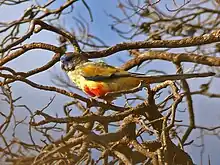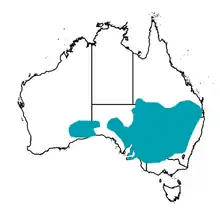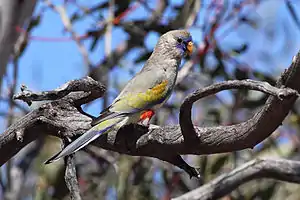| Northiella | |
|---|---|
 | |
| Eastern bluebonnet | |
| Scientific classification | |
| Domain: | Eukaryota |
| Kingdom: | Animalia |
| Phylum: | Chordata |
| Class: | Aves |
| Order: | Psittaciformes |
| Family: | Psittaculidae |
| Tribe: | Platycercini |
| Genus: | Northiella Mathews, 1912 |
| Type species | |
| Northiella haematogaster (Gould, 1838) | |
The term "bluebonnet" refers to the Northiella genus which is subdivided into two species of Australian parrots, these are the Eastern Bluebonnet (Northiella haematogaster; Gould, 1838)[1] and the Naretha Bluebonnet (Northiella narethae; H.L. White, 1921).[2] This genus is named in honor of Australian ornithologist Alfred John North.
Characteristics
The bluebonnet birds are a medium-sized parrot that known for their plumage as this species typically has a variety of colours over its body. Their upper body, back and neck areas are a light brown to grey. With the base of their wings having a dark blue patches.[3] However, this species is primarily known for its crimson-coloured belly, yellow chest and light blue forehead and face.[4][1]
The males within this species group can measure up to 35cm in length with the females measuring to around 32cm. With their weight fluctuating between 70-100 grams[1] depending on the maturity and sex of the bird.
Distribution
This species is found throughout the central land of Australia, extending from the southern Queensland, majority of the New South Wales (excluding the eastern coastline) to Northern Victoria. There is also evidence of this species being found within the State of South Australia and the eastern side of Western Australia.[1]

Habitat
The Bluebonnet birds are primarily found within dry inland areas across south-eastern Australia.[3] The favoured habitat for this species is in the Mallee region of north-west Victoria. Where it is found throughout cleared agricultural landscapes[5]
Taxonomy
Bluebonnets for many years were identified under the genus ‘psephotus’ which categorized them with Red-Rumped Parrot. [6] This is due to Bluebonnets and broad-tailed parrots such as Rosellas sharing common features such as their calls, eating and flight maneuvers. The Northiella Haematogaster where distinguished by their crimson underbelly and the Northiella narethae was further separated by the crimson colour under the tail rather then under the belly. The Eastern Bluebonnet global population is unknown but not classified as threatened. The largest known threat to the Eastern Bluebonnet is the native vegetation clearing in Victoria.[7] Spite of the clearing, the Bonnet is a common bird throughout the south-eastern states of Australia.
Behaviour
The blue bonnet bird is most active within the spring months of the year.[8] They also have a tendency to be found in small groups[3] due to their social behaviour. Where they are found to be most active during dusk and dawn, this is hypothesized to avoid predator encounters with Nankeen Kestrel or other ground dwelling bird eating mammals.[8] Bluebonnets will often stick in pairs and do not seasonally migrate, nor travel far past their home territory.[6]
Diet
The Eastern Bluebonnet have observed drinking patterns of dusk and dawn.The primary diet includes seeds, fruits, small insects and flowers.[8] The Bluebonnet has included introduced vegetation species seeds into its diet such as Buffel Grass and native species such as the saltbush.[8][9]
Species
The genus includes the following two species:[10]
| Image | Scientific name | Common Name | Distribution |
|---|---|---|---|
 | Northiella haematogaster | Eastern bluebonnet | Australia |
| Northiella narethae | Naretha bluebonnet | southeastern Western Australia to southwestern South Australia | |
References
- 1 2 3 4 Australia, Atlas of Living. "Species: Northiella haematogaster (Blue Bonnet)". bie.ala.org.au. Retrieved 2023-10-28.
- ↑ Australia, Atlas of Living. "Species: Northiella narethae (Naretha Blue Bonnet)". bie.ala.org.au. Retrieved 2023-10-28.
- 1 2 3 "Greater Bluebonnet - eBird". ebird.org. Retrieved 2023-10-29.
- ↑ "Bluebonnet | Murrumbidgee Council". www.murrumbidgee.nsw.gov.au. Retrieved 2023-10-28.
- ↑ Emison, W.B. (1992). "The Importance of Remnant Vegetation to the Blue Bonnet in North-western Victoria". The Importance of Remnant Vegetation to the Blue Bonnet in North-western Victoria: 159–164 – via Wildlife Management Branch, Department of Conservation and Environment.
- 1 2 "Bluebonnet - Australian Birds - photographs by Graeme Chapman". www.graemechapman.com.au. Retrieved 2023-11-08.
- ↑ "Bluebonnet (Northiella haematogaster) | Parrot Encyclopedia". www.parrots.org. Retrieved 2023-11-08.
- 1 2 3 4 "Greater Bluebonnet (Northiella haematogaster)". iNaturalist. Retrieved 2023-10-29.
- ↑ "Nankeen Kestrel". The Australian Museum. Retrieved 2023-10-29.
- ↑ Gill F. and Donsker D. (eds), Family Psittaculidae, in IOC World Bird Names (ver 6.2), International Ornithologists’ Union, 2016. URL Retrieved 9 June 2016.